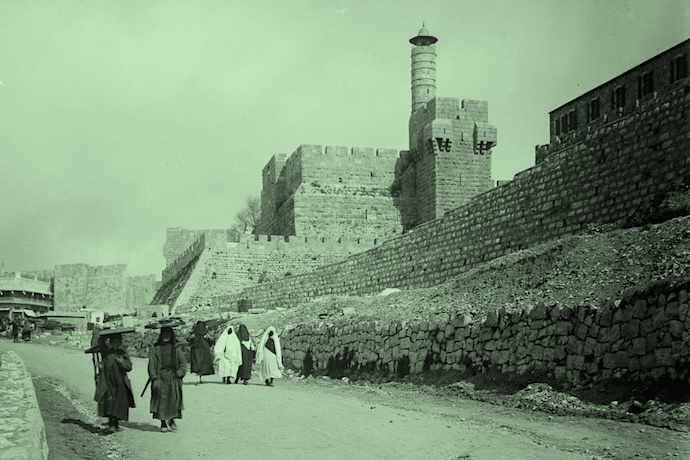Often referred to as an “open-air prison,” Gaza has been turned into, in the words of British-Israeli historian Avi Shlaim, “an open-air graveyard.” This is the same Gaza that drew the USS Gerald R. Ford aircraft carrier thousands of miles to support a “medieval-style siege” of the tiny enclave following October 7, and invited countless responses as to what to do with it. Jared Kushner, for example, prefers to see Israel “move the people out” of the “very valuable” yet underdeveloped “Gaza waterfront property” in order to “clean it up.” In addition to arguing that “We shouldn’t be spending a dime on humanitarian aid,” former pastor and current Congressman Tim Walberg (R-MI) proposes that we “get it over quick,” just “like Nagasaki and Hiroshima.” Lindsey Graham favors “level[ing] the place.”
Perhaps just as troubling, Palestine (the country and the people) was absent from Joe Biden’s initial rhetoric on the war on Gaza. In his earliest speeches after October 7, he focused nearly exclusively on the idea that Israel was “born to be a safe place for the Jewish people,” eliding the presence of indigenous Palestinians on the land and suggesting that Israel evolved organically, rather than from a settler colonial imposition. His current rhetoric, however, is still deeply entangled with his older rhetoric of empire that suggests that Israel did not evolve organically, but was created to protect US interests. For example, in 1986, during his time as a US Senator, Biden suggested that Israel was the United States’s “best $3 billion dollar investment” and famously remarked that “if there were not an Israel,” the US “would have to invent one.” According to this imperial logic, America has mobilized the West to protect its Israeli investment at the expense of Palestine, Palestinians, and their presence on the land.
Evidently, Gaza, and by extension Palestine, means different things to different people; yet since October 7, American politicians and Israeli lawmakers—including Benjamin Netanyahu, Ariel Kallner, and Avi Dichter—have all voiced calls for genocide and ethnic cleansing to restore Israeli deterrence and to effectively maintain colonial control over Gaza, or what many call Israel’s right to defend itself. But this desire to annihilate Gaza transcends the Zionist project and predates October 7, the 1948 Nakba, or even the Holocaust. In fact, a long Euro-American tradition of genocide and ethnic cleansing, both secular and religious, imagined freeing a barren Palestine from Palestinian barbarity and heathenism.
In secular American travel writing, for instance, Ottoman Palestine was either underdeveloped or empty. Palestinians, portrayed either as silent heathens or indigenous savages who hinder progress, had to go. Mark Twain’s The Innocents Abroad (1869) portrayed Palestine as a land infested with marauding Bedouins, overtaken by disease, superstition, and poverty. Palestinians were an unsophisticated, “thankless and impassive race.” Twain imagined that Palestinians with shaven heads were “careful to leave a lock of hair for the Prophet to take hold of” because “a good Mohammedan would consider himself doomed to stay with the damned forever if he were to [die without it].”
Like Native Americans in dime novels, Twain’s cartoonish Palestinians were “Digger Indians” who acted “like a pack of hopeless lunatics,” or irredeemable savages “with very long spears in their hands, cavorting around on old crowbait horses, and spearing imaginary enemies; whooping, and fluttering their rags in the wind.” One man in his group, Twain reported, “was going to scalp such Bedouins as fell to his share, and take his bold-headed sons of the desert home with him alive for trophies.”
In portraying Palestinians as stereotyped Indians, scalping and whooping on horseback, Twain was equating indigenous people in Palestine and the Americas. The colonial solution to both was implied. In the absence of effective stewardship, colonial logic dictated that only Euro-American settlers could transform this unsettled land into a paradise. Indigenous Palestinians were unworthy of it and should be eliminated or displaced, just like the Native Americans to which this discourse compared them.

A Jerusalem street in 1900. Image: rarehistoricalphotos.com
Though espousing a secular worldview, Twain paradoxically presented Palestinians as morally and spiritually corrupt, and therefore dispensable. The holy city of Jerusalem—symptomatic of the rest of multifaith Palestine—he imagined as “mournful, and dreary, and lifeless.” While partly directed at the American Protestant pilgrims in his company, his irreverent satire mainly targeted Catholic and Muslim Palestinians.
This view was typical for American and European missionaries as well. In the American Christian imagination, Ottoman “Christianity and Islam were coupled,” Ussama Makdisi argues, “as the two pillars of temporal and spiritual corruption that had to be struck down.” Twain’s comic depictions of a desolate, barren, and neglected Palestine later serve as documentary evidence in both Christian Zionist and Jewish Zionist publications that use this historically-inaccurate neglected-land trope to justify Israeli settler colonialism.
Other 19th-century Christian travelers arrived for different reasons but came to similar conclusions about the need to dispense with indigenous Palestinians. Prompted by the growing tension between Darwinian evolution and Creationism, European religious pilgrims hoped to find in Palestinian geography, geology, archeology, and indigenous customs material evidence to reinforce the Bible’s historical accuracy and prove the factuality of Genesis. As Elias Sanbar shows, they thought this proof would challenge the emergent evolutionary science’s geology. But the “redemption of the land, [and] illegitimate presence of Palestinians in Palestine” quickly became core values.
Along these lines, British Restorationist Alexander Keith mythicized Palestine into “a country without a people” waiting to be restored to “a people without a country” in his 1844 book, The Land of Israel: According to the Covenant with Abraham, Isaac, and with Jacob. A half century later, American Restorationist Robert Laird Stewart applied colonialist Christian historiography to appropriate Palestinian geography by using Biblically-defined boundaries. His 1899 book, which shares a title with Keith’s, The Land of Israel: A Text Book on the Physical and Historical Geography of the Holy Land Embodying the Results of Recent Research, renamed modern geography and urban locations, erasing modern Palestinians, and inscribing Jews as the exclusive tenured tenants.
Palestine was, according to Stewart, the “land of the Patriarchs,” “the Prophets,” “the Sacred Poets,” “the Apostles,” and “David and Solomon.” Palestine was not the land of the “Moslem hordes from the desert,” Stewart argued, or the property of “the Arabs or their successors [read: Palestinians], and co-religionists, the Turks.” The message was simple: under nomadic Palestinian and corrupt Ottoman Islam, Palestine fell to ruins, but it will prosper in the hands of Euro-American Christians who will restore it by establishing a settler-colonial Jewish presence. Stewart’s geography of Ottoman Palestine Judaized the land and erased Palestinian belonging all in service of the Western Christian colonialist project.
Inventing narratives of Jewish restoration to the Holy Land, Keith and Stewart created a foundational myth that fueled a Zionist discourse bent on using force to establish a settler-colonial Jewish state in Palestine and attracted a Euro-American political elite in support of it. In 1901, Keith’s myth was adopted by Jewish Zionists because, according to Karl Sabbagh in Palestine: A Personal History, it gave “the false impression that Palestine was uninhabited when Jews decided to agitate for it to become their state”—“a land without a people for a people without a land” as the saying goes.
Uninhabited in their imagination but very much inhabited in everyday life, Christian dispensationalism and Jewish Zionism formed an uneasy alliance; mutually reinforcing traditions bent on depopulating indigenous Palestine while forcing Jewish-Zionist colonization. In support of the Zionist project, most notably, British colonialist Arthur Balfour, a Christian Zionist, mobilized Britain, France, Italy, and the United States and issued the Balfour Declaration in 1917. According to this official document, the British Crown promised to establish a European-Jewish homeland in Arab-majority Palestine at the expense of indigenous majority Palestinians. In 1919, with utter disregard for the Palestinians, Balfour attributes this support to shared colonialist and messianic values; in the same year, according to Walid Khalidi, Balfour declared in a memorandum that the “four great powers are committed to Zionism. And Zionism, be it right or wrong, good or bad, is rooted in age-long traditions, in present needs, in future hopes, of far profounder import than the desires and prejudices of the 700,000 Arabs who now inhabit that ancient land.”
American travel writing, Christian Zionism, evangelical dispensationalism, Jewish Zionism—the success of the ethnic cleansing of Palestine discourse has many fathers. Fast forward more than a century, and self-proclaimed Zionist Joe Biden still honors Balfour’s legacy. But as a result of creating and maintaining the settler-colonial Zionist state, Palestinians in 1948 experienced ethnic cleansing and what genocide scholar Martin Shaw calls an “incipiently genocidal mentality,” and they’ve been systematically displaced since. Indeed, Political Zionism, as Nur Masalha points out in The Bible and Zionism, adopted “the Protestant Zionist biblicist doctrine of exclusive land ownership” and “developed a theory of ethnic and racial superiority” over the Palestinians “on the basis of the land and conquest traditions of the Hebrew Bible, especially on the Book of Joshua and those dealing with Israelite origins that demanded the subjugation and destruction of other peoples.” It is no surprise then that Benjamin Netanyahu urged his Gaza-invading soldiers to “remember what Amalek has done to you” and act accordingly to “blot out” its memory.
Banking on this unholy matrimony between Christian and Jewish Zionisms, Netanyahu has systematically attempted to sell the genocidal war on Gaza as “a struggle between the children of light and the children of darkness.” The Muslims are coming, Netanyahu implies in a clash-of-civilizations tone, declaring, “I tell our friends in the enlightened world: Our war is also your war. If we do not stand together in a united front, it will reach you as well.”
In their different ways, Netanyahu and Biden—in spite of the latter’s recent timid criticism of the former—echo the longstanding and multi-sourced discourse of erasing the presence of indigenous Palestine, while simultaneously imposing Euro-American inscriptions. The latest in this genealogy of erasure, Israel is—according to many human rights experts, UN specialists, ICC prosecutors, ICJ rulings, and other observers—currently executing the genocidal intent Twain, Keith, Stewart, and others fantasized about. When American and Israeli figures say the quiet part out loud, be it fabulous beachfront property, atomic destruction, or biblical “blotting” out of memory, they remind us that ethnically cleansing the Palestinians has long been a colonial dream. Israel, the colony, appears to be turning the dream into an apocalyptic reality.


